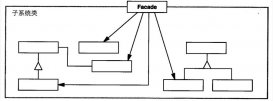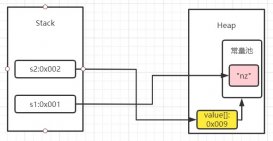在web.xml中我们除了配置actionservlet还配置了一些初始化参数信息,首先我们看第一个config参数,这里配置的是/web-inf/struts-config.xml,因为要下面传递一个这样一个配置信息,这个xml文件名是struts1标准的名字,所以这里这个初始化信息完全可以删除,如果不用这个标准名称这里就必须要在这里配置。现在我们配置的是标准名字,所以我们可以删除,这是为什么呢?这里要看actionservlet源代码才可以。

从图片上我们能看到actionservlet中已经写好了默认的config信息了,就是标准名字。所以这里删除也是可以的。
在看下面的debug和detail参数,这两个参数信息是有关日志信息级别的设置,主要关于解析配置文件/web-inf/struts-config.xml级别的初始化参数。这里这两个参数可以完全去掉也不影响。
最后还有一个load-on-startup配置,这个是初始化servlet级别的初始化信息,这个参数如果大于等于0就是说明在服务器一启动就把servlet初始化,也就是调用actionservlet的init方法,这个也可以到actionservlet的源代码中去查找。
当actionservlet初始化的时候就会读取/web-inf/struts-config.xml信息到内存中,读到内存是以什么样的形式展现的呢?我们现在可以看一下以前博客的那个mvc实例,那里面读取配置文件中的信息是以actionmapping的形式展现的。另外servlet-mapping的配置就不讲解了,这个都知道就是匹配url路径的,当遇到url-pattern的路径时候就会实例化actionservlet。
通过这篇文章我们知道了当我们请求的时候actionservlet是怎样实例化的,也知道为什么我们要配置web.xml信息了。那么我们为什么要配置/web-inf/struts-config.xml文件,actionservlet是如何传递请求的,如何和actionform、actionmapping、action等交互的最终完成用户请求的呢?
我们先从actionservlet源代码的init方法开始。因为actionservlet就是一个servlet,它也是具有典型的那几个方法init、doget、dopost等方法。既然是初始化,那么我们就要看init方法。init方法的源代码如下:
|
1
2
3
4
5
6
7
8
9
10
11
12
13
14
15
16
17
18
19
20
21
22
23
24
25
26
27
28
29
30
31
32
33
34
35
36
37
38
39
40
41
42
43
44
45
46
47
48
49
50
51
52
53
54
55
56
57
58
|
/** * <p>initialize this servlet. most of the processing has been factored into * support methods so that you can overrideparticular functionality at a * fairly granular level.</p> * * @exception servletexception if we cannotconfigure ourselves correctly */ publicvoidinit() throwsservletexception { // wraps the entire initialization in a try/catch tobetter handle // unexpected exceptions and errors to provide better feedback // to the developer try { initinternal(); initother(); initservlet(); getservletcontext().setattribute(globals.action_servlet_key, this); initmoduleconfigfactory(); // initialize modules as needed moduleconfig moduleconfig =initmoduleconfig("", config); initmodulemessageresources(moduleconfig); initmoduledatasources(moduleconfig); initmoduleplugins(moduleconfig); moduleconfig.freeze(); enumeration names =getservletconfig().getinitparameternames(); while (names.hasmoreelements()) { string name = (string)namesnextelement(); if (!name.startswith("config/")) { continue; } string prefix =name.substring(6); moduleconfig = initmoduleconfig (prefix,getservletconfig().getinitparameter(name)); initmodulemessageresources(moduleconfig); initmoduledatasources(moduleconfig); initmoduleplugins(moduleconfig); moduleconfig.freeze(); } this.initmoduleprefixes(this.getservletcontext()); thisdestroyconfigdigester(); } catch (unavailableexception ex) { throw ex; } catch (throwable t) { // the follow error message is not retrieved from internal message // resources as they may not have been able to have been // initialized logerror("unable to initialize struts actionservlet due to an " + "unexpected exception or error thrown, so marking the " + "servlet as unavailable. mostlikely, this is due to an " + "incorrect or missing library dependency.", t); throw new unavailableexception(t.getmessage()); } } |
在解释这段代码的流程和意思之前,有必要说一句,就是当我们在eclipse里面看代码的时候,尤其是看一段生疏的很长的代码的时候,希望能够经常使用ctrl键(多余的不解释)。
下面开始讲解这段代码的流程和具体每一步的含义,如果有不正确的地方,希望指正。
首先映入眼帘的是initinternal()方法。这个方法的实现代码是:
代码段一:
|
1
2
3
4
5
6
7
8
9
10
11
12
13
14
15
16
17
18
19
|
/** * <p>initialize our internal messageresourcesbundle</p> * * @exception servletexception if we cannotinitialize these resources */ protectedvoidinitinternal() throwsservletexception { // :fixme: document unavailableexception try { internal = messageresourcesgetmessageresources(internalname); } catch (missingresourceexception e) { log.error("cannot load internal resources from '"+ internalname+ "'", e); throw new unavailableexception ("cannot load internal resources from '"+ internalname+ "'"); } } |
代码段二:
|
1
2
3
4
5
6
7
8
9
10
11
12
13
14
|
/** * create and return an instance of <code>messageresources</code> for the * created by the default <code>messageresourcesfactory</code>. * * @param config configuration parameterfor this message bundle. */ publicsynchronizedstaticmessageresources getmessageresources(string config) { if (defaultfactory == null) { defaultfactory =messageresourcesfactory.createfactory(); } return defaultfactory.createresources(config); } |
代码段三:
|
1
2
3
4
5
6
7
8
9
10
11
12
13
14
15
16
17
18
19
20
21
|
/** * create and return a <code>messageresourcesfactory</code> instance ofthe * appropriate class, which can be used tocreate customized * <code>messageresources</code>instances if no such factory can be * created, return <code>null</code> instead */ publicstaticmessageresourcesfactory createfactory(){ // construct a new instance of the specified factory class try { if (clazz == null) clazz = requestutils.applicationclass(factoryclass); messageresourcesfactory factory = (messageresourcesfactory) clazz.newinstance(); return (factory); } catch (throwable t) { log.error("messageresourcesfactory.createfactory",t); return (null); } } |
这个方法的具体作用就是初始化messageresources,具体实现是工厂模式,首先判断defaultfactory是否存在,不存在则创建工厂,defaultfactory = messageresourcesfactory.createfactory(),在通过工厂创建资源类defaultfactory.createresources(config);存在则直接创建资源类。
initother()的方法,主要是初始化其它的配置,获取我们自己的struts-config配置文件的路径,而它的默认路径就是web-inf/struts-config.xml,另外这个方法还会注册一些转换类的。具体源代码是:
|
1
2
3
4
5
6
7
8
9
10
11
12
13
14
15
16
17
18
19
20
21
22
23
24
25
26
27
28
29
30
31
32
33
34
35
36
37
38
39
40
|
/** * <p>initialize other global characteristics ofthe controller servlet</p> * * @exception servletexception if we cannotinitialize these resources */ protectedvoidinitother() throwsservletexception { string value = null; value =getservletconfig().getinitparameter("config"); if (value != null) { config = value; } // backwards compatibility for form beans of java wrapper classes // set to true for strict struts 0 compatibility value =getservletconfig().getinitparameter("convertnull"); if ("true".equalsignorecase(value) || "yes".equalsignorecase(value) || "on".equalsignorecase(value) || "y".equalsignorecase(value) || "1".equalsignorecase(value)) { convertnull = true; } if (convertnull) { convertutils.deregister(); convertutils.register(new bigdecimalconverter(null), bigdecimal.class); convertutils.register(new bigintegerconverter(null), biginteger.class); convertutils.register(new booleanconverter(null), boolean.class); convertutils.register(new byteconverter(null), byte.class); convertutils.register(new characterconverter(null), character.class); convertutils.register(new doubleconverter(null), double.class); convertutils.register(new floatconverter(null), float.class); convertutils.register(new integerconverter(null), integer.class); convertutils.register(new longconverter(null), long.class); convertutils.register(new shortconverter(null), short.class); } } |
initservlet()方法是利用digester读取web.xml文件并且放到servletcontext中。具体实现源代码:
|
1
2
3
4
5
6
7
8
9
10
11
12
13
14
15
16
17
18
19
20
21
22
23
24
25
26
27
28
29
30
31
32
33
34
35
36
37
38
39
40
41
42
43
44
45
46
47
48
49
50
51
52
53
54
55
56
57
58
59
60
61
62
63
64
65
66
67
68
69
70
71
72
73
74
75
76
|
/** * <p>initialize the servlet mapping under which our controller servlet * is being accessed. this will be used in the <code>&html:form></code> * tag to generate correct destination urls for form submissions.</p> * * @throws servletexception if error happens while scanning web.xml */protected void initservlet() throws servletexception { // remember our servlet name this.servletname = getservletconfig().getservletname(); // prepare a digester to scan the web application deployment descriptor digester digester = new digester(); digester.push(this); digester.setnamespaceaware(true); digester.setvalidating(false); // register our local copy of the dtds that we can find for (int i = 0; i < registrations.length; i += 2) { url url = this.getclass().getresource(registrations[i+1]); if (url != null) { digester.register(registrations[i], url.tostring()); } } // configure the processing rules that we need digester.addcallmethod("web-app/servlet-mapping", "addservletmapping", 2); digester.addcallparam("web-app/servlet-mapping/servlet-name", 0); digester.addcallparam("web-app/servlet-mapping/url-pattern", 1); // process the web application deployment descriptor if (log.isdebugenabled()) { log.debug("scanning web.xml for controller servlet mapping"); } inputstream input = getservletcontext().getresourceasstream("/web-inf/web.xml"); if (input == null) { log.error(internal.getmessage("configwebxml")); throw new servletexception(internal.getmessage("configwebxml")); } try { digester.parse(input); } catch (ioexception e) { log.error(internal.getmessage("configwebxml"), e); throw new servletexception(e); } catch (saxexception e) { log.error(internal.getmessage("configwebxml"), e); throw new servletexception(e); } finally { try { input.close(); } catch (ioexception e) { log.error(internal.getmessage("configwebxml"), e); throw new servletexception(e); } } // record a servlet context attribute (if appropriate) if (log.isdebugenabled()) { logdebug("mapping for servlet '" + servletname + "' = '" + servletmapping + "'"); } if (servletmapping != null) { getservletcontext().setattribute(globals.servlet_key, servletmapping); } } |
首先说在说之前还是先讲init方法的具体实现代码写出来以便大家方便阅读和理解。
init源代码:
|
1
2
3
4
5
6
7
8
9
10
11
12
13
14
15
16
17
18
19
20
21
22
23
24
25
26
27
28
29
30
31
32
33
34
35
36
37
38
39
40
41
42
43
44
45
46
|
public void init() throws servletexception { try { //初始化资源类 initinternal(); //注册转换类 initother(); //利用digester读取webxml文件并且将其放到servletcontext中 initservlet(); getservletcontext().setattribute(globals.action_servlet_key, this); initmoduleconfigfactory(); moduleconfig moduleconfig = initmoduleconfig("", config); initmodulemessageresources(moduleconfig); initmoduledatasources(moduleconfig); initmoduleplugins(moduleconfig); moduleconfig.freeze(); enumeration names = getservletconfig().getinitparameternames(); while (names.hasmoreelements()) { string name = (string) names.nextelement(); if (!name.startswith("config/")) { continue; } string prefix = name.substring(6); moduleconfig = initmoduleconfig (prefix, getservletconfig()getinitparameter(name)); initmodulemessageresources(moduleconfig); initmoduledatasources(moduleconfig); initmoduleplugins(moduleconfig); moduleconfig.freeze(); } this.initmoduleprefixes(this.getservletcontext()); this.destroyconfigdigester(); } catch (unavailableexception ex) { throw ex; } catch (throwable t) { log.error("unable to initialize struts actionservlet due to an " + "unexpected exception or error thrown, so marking the " + "servlet as unavailable most likely, this is due to an " + "incorrect or missing library dependency", t); throw new unavailableexception(t.getmessage()); } } |
getservletcontext().setattribute(globals.action_servlet_key,this);这句话是将actionservlet实例将以globals.action_servlet_key作为key存入servletcontext中。
这里的globals.action_servlet_key在actionservlet已经给出了声明:
|
1
|
public static final string action_servlet_key= "org.apache.struts.action.action_servlet"; |
接下来initmoduleconfigfactory()方法,这个方法主要的作用是解析在web.xml中configfactory的text值。如果configfactory有配置,则将设置moduleconfigfactory中得factoryclass值,否则默认得为efaultmoduleconfigfactory。该方法其实宗旨是让开发人员自己开发出moduleconfigfactory,从而得到自己所需要的moduleconfig类。因为我们的实例中没有配置这个参数信息,所以我们这里的实例是要defalutmodelconfigfactory了。
代码段一:
|
1
2
3
4
5
6
|
protected voidinitmoduleconfigfactory(){ string configfactory =getservletconfig().getinitparameter("configfactory"); if (configfactory != null) { moduleconfigfactory.setfactoryclass(configfactory); } } |
代码段二:
|
1
2
3
4
|
public static void setfactoryclass(string factoryclass) { moduleconfigfactory.factoryclass = factoryclass; moduleconfigfactory.clazz = null; } |
代码段三:
|
1
2
3
|
protected static string factoryclass = "org.apache.struts.config.impl.defaultmoduleconfigfactory"; } |
moduleconfig moduleconfig =initmoduleconfig("", config)方法是非常重要的,initmoduleconfig方法给strits-config里面的属性初始化后放入moduleconfig对象里面去,放到moduleconfig对象里面去便于以后操作更快,因为它是文件流。
具体实现代码:
|
1
2
3
4
5
6
7
8
9
10
11
12
13
14
15
16
17
18
19
20
21
22
23
24
25
26
27
28
29
30
31
32
33
34
35
36
37
38
39
40
41
42
43
44
45
46
47
48
49
50
51
52
53
54
55
56
57
|
protected moduleconfig initmoduleconfig(stringprefix, string paths) throws servletexception { // :fixme: document unavailableexception? (doesn't actually throw anything) if (log.isdebugenabled()) { log.debug( "initializing module path '" + prefix + "' configuration from '" + paths + "'"); } // parse the configuration for this module moduleconfigfactory factoryobject= moduleconfigfactory.createfactory(); moduleconfig config =factoryobject.createmoduleconfig(prefix); // configure the digester instance we will use digester digester =initconfigdigester(); // process each specified resource path while (paths.length() > 0) { digester.push(config); string path = null; int comma = paths.indexof(','); if (comma >= 0) { path =paths.substring(0, comma).trim(); paths =paths.substring(comma + 1); } else { path = pathstrim(); paths = ""; } if (pathlength() < 1){ break; } this.parsemoduleconfigfile(digester,path); } getservletcontext().setattribute( globals.module_key +config.getprefix(), config); // force creation and registration of dynaactionformclass instances // for all dynamic form beans we wil be using formbeanconfig fbs[] =config.findformbeanconfigs(); for (int i = 0; i < fbs.length; i++) { if (fbs[i].getdynamic()) { fbs[i].getdynaactionformclass(); } } return config; } |
这里有必要解析一下这段代码。首先得到继承moduleconfigfactory的实现类,如果在initmoduleconfigfactory()中能设置factoryclass属性,则能生成客户化得factory,否则得到得是默认得defaultmoduleconfigfactory类,该工厂得到moduleconfigimpl类。然后调用initconfigdigester()该方法为解析配置文件做准备,初始化digest类(具体digest的初始化实现就不讲解)。最后返回moduleconfig,而这时的moduleconfig里面封装了所有的struts-config.xml中的信息。
最后的几个方法就简单说一下就行,不是非常难理解:
initmodulemessageresources(moduleconfig)方法是通过moduleconfig中的配置文件信息,创建messageresource对象.
initmoduledatasources(moduleconfig)方法是通过moduleconfig中的配置文件信息,创建datasource对象. initmoduleplugins(moduleconfig)加载并初始化默认应用模块的所有插件的。
moduleconfig.freeze()是将配置文件中的各个对象,设置成已配置状态.
最后我们看到了,下面还有一段同上面代码的循环代码,这段代码的主要意思就是当默认子应用模块被成功初始化后,如果应用还包括其他子应用模块,将重复流程,分别对其他子应用模块进行初始化。这个也是很好理解的。
到此为止actionservlet就init完成。















